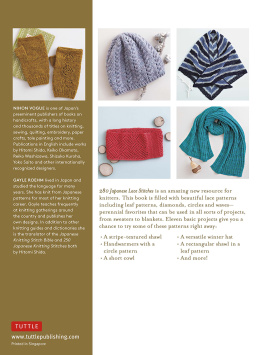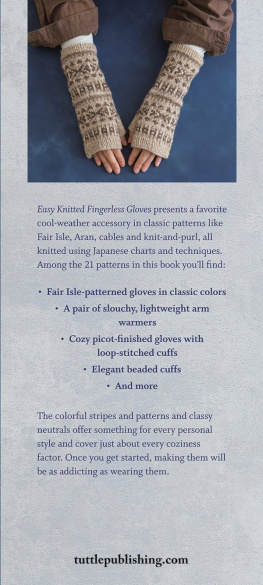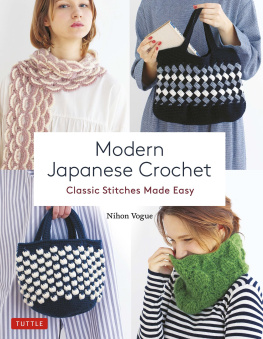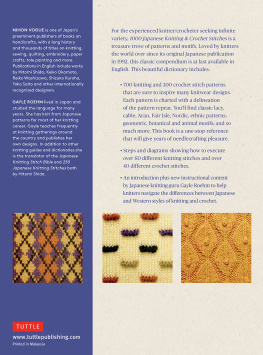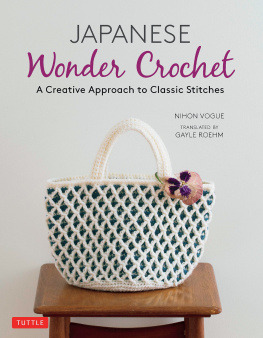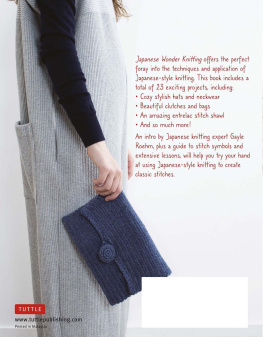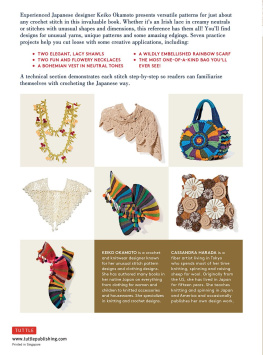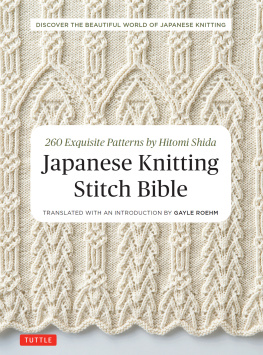Contents
This collection presents 280 stitch patterns and some
accessories in the form of charts with symbols to repre-
sent the knitted stitches. Its important to keep in mind
that all charts show the completed pattern on the right
side of the work. If a symbol is worked on the wrong
side, its also explained.
Most charts include blank boxes. At the bottom of each
chart, look for a key to define the blanks: much of the
time, a blank represents a knit stitch on the right side,
but it may represent a purl in others.
The way to read and use the charts is explained on pages
so please be sure to read those pages and
make use of the explanations when you work one of the
patterns.
This book includes popular stitch patterns from
Openwork Stitch Patterns (Nihon Vogue, Japanese only).
It has been revised and some new stitches added.
It is prohibited to sell items made from the projects in
this book in stores, online auctions, and the like. Please
enjoy them for your personal use.
Note: A table of stitch patterns by number of
repeats can be found on
INTRODUCTION
Ready for more beautiful Japanese lace stitches? Heres another lovely collection from Nihon Vogue. Unlike some
of the previous translations from Tuttle, these stitches arent the product of a single designer. Instead, the book
is a compilation of patterns from a number of out-of-print books. The Japanese title of the principal source was
280 Openwork Patterns, making the selection somewhat broader than lace. Youll find a few cables and crossed
stitches, but the focus is on patterns created with yarnovers and decreases. You may also find that these stitches are
less complex than those created by Hitomi Shida or Keiko Okamoto, but still rewarding to knit.
Most importantly, you should be comfortable knitting from charts, whether knit or crochet. Japanese designs
dont provide stitch patterns in words. The chart-phobic knitter or crocheter should probably give this book a pass.
Even if youve used other Japanese stitch dictionaries, be sure to read through this introduction and that on
, to be sure youre familiar with the conventions of this book.
CHART BASICS
The beautiful stitch patterns in this book are presented in the form of charts, using symbols to describe each stitch.
Pages 16 and 17 give you examples of charts, and describe how to interpret them. The single most important thing
to remember about working from charts is this:
The chart shows the right side of the work .
Its a visual representation of what your work will look like when its done. Each symbol describes what the stitch
will look like on the right side, not what you execute. For example, to create a knit stitch on the right side, you must
purl on the reverse side.
If youre knitting back and forth:
On the right side , read the chart from right to left, in the same sequence that you work the stitches.
On the reverse (or wrong) side , read the chart from left to right, and reverse the stitches , so that your stitches
will show up correctly on the right side.
A few decreases and yarnovers are worked on the wrong side. In each case, a footnote to the chart will remind
you how to work the WS version of the stitch.
If youre knitting in the round, read every row from right to left. Theres no need to reverse stitches. Find a good
way to keep your place in the chart, whether its marking off rows, highlighter tape, a PDF reader on your device,
or some other means.
Row numbers appear on the right side of the chart, and stitch numbers at the bottom. The rightmost column
and the bottommost row are not stitches, but holders for the numbers. Notice that only the repeated stitches and
rows are numbered, and the repeat may not begin in the lower right corner. Theres a heavy line around the repeat
on the chart, as well. If there are stitches to the right of the repeat, use those stitches to begin your item, and
mirror-image them on the left after the end of the last repeat.
Most charts show more than a single repeat, to make the charts similar in size and to fit on the page.
SYMBOL BASICS
All Japanese publishers use the same standardized set of stitch symbols, so every knitter or crocheter is expected
to know them. Japanese stitch symbols are drawn to resemble the finished stitch, and once youre accustomed to
them, youll see the visual correlation.
All of the symbols used in this book are defined, with illustrations, in the technique section at the back. A few
variations are footnoted on the appropriate chart. In almost all charts, there are lots of blank boxes that form the
background of the openwork pattern. Check the key at the bottom left corner to find how to read the blank. For
instance:
tells you that a blank box looks like a knit stitch on the right side.
tells you that a blank box looks like a purl stitch on the right side.
This convention keeps the chart cleaner and easier to readyour eye can focus on what you have to do, with-
out a lot of visual noise from the background stitches. Compare stitch patterns 1 and 8, for instance. Pattern 1
has a stockinette stitch background, while pattern 8 is based on reverse stockinette.
The first row of each chart is the cast-on row, almost always shown as knits. Unless otherwise indicated, Japa-
nese patterns customarily use the long-tail cast-on, which produces knit stitches on the right side.
PRACTICE PATTERNS
There are eleven practice projects, shown on : five scarves or shawls, one cowl, one hat, one headband,
and two fingerless mitts or armwarmersone size fits all. Theyre well-thought-out to provide practice with the
stitch charts, the symbols and the format of a Japanese knitting pattern. Some are worked flat, and some in the
round.
The yarns used in the practice projects are not widely available outside Japan, so weve provided approximate
weight and yardage to help you make substitutions. For fiber content and other information about the original
yarns, see the yarn table on .
The instructions for the practice patterns are mostly contained in the graphics: the schematics (line drawings of
the piece) and stitch pattern charts (discussed above).
The schematics provide information about measurements, stitch counts, stitch placement, color placement and
shaping. In a way, the schematics show you what you need to do, so read through them before you begin. Some
conventions in the schematics are:
An arrow shows the direction of work .
A line across the schematic means pay attention, because something happens there. It may be a change of
stitch pattern (from ribbing to stockinette, say), it may be a change of needle or hook size, it may be a change of

